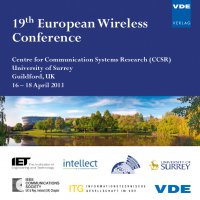Finding Partially Link-Disjoint Paths in Wireless Sensor Networks
Konferenz: European Wireless 2013 - 19th European Wireless Conference
16.04.2013 - 18.04.2013 in Guildford, UK
Tagungsband: European Wireless 2013
Seiten: 6Sprache: EnglischTyp: PDF
Persönliche VDE-Mitglieder erhalten auf diesen Artikel 10% Rabatt
Autoren:
Seymour, Zachary (Department of Computer Science, Indiana University of Pennsylvania Indiana, PA 15701)
Kar, Dulal (Department of Computing Sciences, Texas A&M University–Corpus Christi, Corpus Christi, TX 78412)
Inhalt:
Routing in wireless sensor networks provides an interesting problem distinct from typical network routing. Due to features such as omnidirectional antennas, finite battery power, and wireless multicast, new shortest path algorithms must be developed to accommodate the benefits and disadvantages of using these networks. We propose a technique for finding partially linkdisjoint paths in wireless ad-hoc networks. Our primary result is an algorithm for producing such paths. This algorithm adapts existing node- and link-disjoint path algorithms to reuse nodeto- node links. By successively removing the link with the lowest energy cost from the path, we can iteratively build a partially link-disjoint path. Our results show that this technique achieves significant energy savings over other node-disjoint or fully linkdisjoint routing algorithms. These findings seem to indicate that, while removal of this link may detract from short-term energy savings, overall energy savings are increased in the long-term. In addition, we present alternative link-removal techniques and their potential applications and usefulness. Finally, we address some potential issues with these types of paths and their utility in the greater problem of ad-hoc network routing. These algorithms provide an alternative to traditional disjoint path algorithms for wireless ad-hoc networks and attempt to address the problems that arise from using partially disjoint paths.


